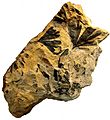Paleobotany facts for kids

Paleobotany is a cool science that helps us understand plants from long, long ago. It's a special part of paleontology, which is the study of ancient life. Paleobotanists are like plant detectives. They search for and identify plant fossils to learn about plants that lived millions of years ago.
This science also helps us figure out what past environments were like. It even teaches us about the history of agriculture and how humans started growing their own food. Tiny fossil pieces like pollen and spores are super important for studying plant history. Scientists who study these tiny fossils are part of micropaleontology and palynology.
Contents
What is Paleobotany?
Paleobotany is the study of ancient plant life. It looks at how plants have changed over millions of years. By studying plant fossils, scientists can learn about plants that are now extinct. They can also see how modern plants are related to their ancient ancestors.
How Do Paleobotanists Find Fossils?
Paleobotanists often look for fossils in places where old plants were buried. These places can be in rocks, coal beds, or even in special rocks called chert. When plants die, they can sometimes get covered quickly by mud or sand. Over time, this mud and sand turn into rock, preserving the plant's shape.
What Kinds of Plant Fossils Are There?
Plant fossils can be many things. They can be whole leaves, stems, or even seeds. Sometimes, only the impression of a plant is left in the rock. Other times, the plant material itself turns into stone. This process is called petrification.
Tiny Clues: Pollen and Spores
Even tiny things like pollen and spores can become fossils. These microscopic bits are very tough. They can survive for millions of years in rocks and soil. By studying fossil pollen and spores, scientists can learn about the types of plants that lived in an area. They can also see how climates changed over time.
Why is Paleobotany Important?
Paleobotany helps us understand Earth's past. It shows us how plants have adapted to different climates. It also helps us predict how plants might change in the future.
Understanding Ancient Environments
Imagine trying to picture a world from millions of years ago. Paleobotanists can do this by studying plant fossils. Different plants need different conditions to grow. For example, finding fossil ferns might mean an area was once wet and warm. Finding fossil pine trees might mean it was cooler. This helps us build a picture of ancient landscapes.
Learning About Earth's Climate History
Plants are very sensitive to climate. By studying plant fossils from different time periods, scientists can see how Earth's climate has changed. They can tell if it was warmer or colder, wetter or drier. This information is very important for understanding our planet's climate today.
Connecting to Our Daily Lives
Paleobotany also connects to things we use every day. For example, Coal is a black rock that we burn for energy. It formed from ancient plants that were buried and compressed over millions of years. Paleobotanists study these plant remains to understand how coal formed.
Another interesting find is Coal balls. These are strange, round plant remains found in coal deposits. They are not made of coal themselves, but they give us amazing details about the plants that formed the coal.
The Rhynie chert is a special fossil deposit in Scotland. It has incredibly well-preserved plant fossils from the early Devonian period. These fossils are so detailed that scientists can see the actual cells of the plants. This helps us learn about the very first land plants.
Images for kids
-
A fossil Betula leopoldae (birch) leaf from the Early Eocene of Washington state, approximately 49 million years ago
-
Lycopod axis (branch) from the Middle Devonian of Wisconsin.
-
Stigmaria, a common fossil tree root. Upper Carboniferous of northeastern Ohio.
-
External mold of Lepidodendron from the Upper Carboniferous of Ohio.
See also
 In Spanish: Paleobotánica para niños
In Spanish: Paleobotánica para niños







